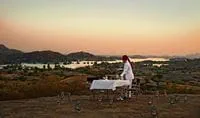Walking in Japan: The Best Hiking Trails for All Skill Levels
Japan offers some of the most beautiful natural landscapes in Asia, from dormant volcanoes to sacred forest paths. Walking in Japan is the perfect way to see these natural treasures, and with the help of our specialists, we’ve gathered the best hiking trails in Japan to get you started.
05 January 2023

From the world-renowned Nakasendo and Kumano Kodo walking trails to hiking on and around Mount Fuji, walking in Japan is a rich and rewarding experience. You will pass exceptional scenery, discover ancient villages, and stay in exquisite ryokans. Initially created as a place for exhausted travelers to rest and rejuvenate, there is no better place to experience authentic Japanese hospitality.
Plus, there are routes for all abilities, from the avid hiker to active families and older travelers wanting to see a different side of Japan.
Our Top Hiking Trails
Read on to find out where to start your discovery of Japan’s beautiful natural world.
Mount Misen

Miyajima Island is normally recognized for its iconic Grand Torii Gate, which appears to float offshore, however, hiking on the island should not be overlooked. Mount Misen has some wonderful treks and on a good day, you can see as far as Hiroshima city. There are three trails, which take you up the mountain. Our favorite is the Daisho-in Course, thanks to its stunning views and manageable incline. It takes between an hour and a half to two hours to walk from the base to the summit. There is also a cable car, which stops at several stations on the way up, eventually dropping visitors out at a station about 300 ft from the top. From here, you can walk half a mile to the peak of the mountain. Look out for the selection of exquisitely, detailed temple structures when you get there, they belong to the Daisho-in temple at the base of the mountain.
Skill Level: Very easy. And to make it even easier, you could take the cable car up or down and only walk one way.
Best Time to go: Mount Misen is beautiful all year round. However, as with most Japan hikes, the best time of year is spring (March, April, May) and fall (September, October, November). This is when you get nice clear skies to make the most of the stunning views.
Who would like this?: You do need to be fit and active to enjoy this hike, but it is still accessible to everyone, from families to older travelers.
Nakasendo Walking Trail

Nakasendo Trail, an old postal service route between Kyoto and Tokyo, will transport you back in time through ancient Japan. While it is now occupied by keen hikers rather than the samurais that once walked its paths, it is easy to envisage what the trail was like in its prime. Stopping off at traditional Japanese ryokans, to rest tired legs adds to the authenticity of the experience.
We recommend a three-day self-guided journey along this charming highway, from the scenic town of Magome to the more energetic town of Narai, characterized by the rows of antiquated houses that line this stretch of road. We think this is possibly the prettiest section of the trail, passing through many of the route’s most attractive postal towns, taking in waterfalls, bamboo forests, cherry blossom trees, a myriad of birds and wildlife, as well as several beautiful Shinto shrines, which have existed since the Edo period.
Skill Level: Easy. The Nakasendo Trail is not a challenging walk, the paths wind up gently and are evenly paved. If you would prefer to just do certain parts of this route, then you can jump on a bus or train to get to the next stop.
Best Time to go: If you’d like to experience the beauty of the cherry blossom on this walk in Japan, visit in spring, especially from the beginning of April to the end of May. Equally, June is a lovely month when the weather is warm but not too hot. Fall also provides perfect hiking weather, when the trees have turned into a blanket of orange and red. The best months in the fall are from late September to the end of November.
Who would like this?: This is not one for the most avid adventurers, it is an easy walk for honeymooners, families, and travelers who would like to see an alternative to Japanese city life.
Mount Takao

One of the closest hiking areas to Tokyo, Mount Takao is less than an hour by train from Japan’s capital, making it the perfect option for those wanting to squeeze some spectacular scenery into a city break. You can easily visit in a day. Seven beautiful walking trails offer up numerous ways to explore the mountain. The hike from the base to the summit takes about 90 minutes, but there is also the option to take a cable car to the halfway point, before climbing to the top on foot. The showstopper here is the view of Tokyo from the very top, the sheer size of this expansive city is a sight to see, and on a cloudless day, views even go as far as Mount Fuji.
Skill Level: Easy to moderate. There are several trails for a mix of abilities so take your pick according to your comfort level.
Best Time to go: Mount Takao is a beautiful place to go hiking in Japan all year round, although spring and fall are when its flora and fauna are most beautiful. This is when the flowers are out, or the trees are turning orange and red. You will also get the best weather in spring and fall, the summer can be extremely hot and humid, while the winter gets cold.
Who would like this?: Mount Takao is suitable for all types of hikers – from families to older, active walkers.
Kumano Kodo

The Kumano Kodo is one of only two UNESCO-listed pilgrimage routes in the world, along with the Camino de Santiago in Spain. While it is not as well-known as its Spanish equivalent, the Kumano Kodo provides completely astounding views of rural Japan and is only an hour south of Osaka by train. The trails are decorated with small shrines that have grown over time, from ancient trees to large rocks, which have been worshipped by pilgrims and ancient emperors since time began. Whether you come here to experience the area’s deep-rooted spirituality or purely to discover the striking scenery, the trails of Kumano Kodo offer some of the best walking in Japan. There are seven different courses in total, as well as a bus that connects the main stopping points, so it’s possible to adjust the hiking to your fitness level or time restraints.
Skill Level: Moderate. The hiking trails are not too difficult, but they are long, taking approximately 6-10 hours each. If you stay at the Amanemu you can arrange to be collected by a driver at any point, allowing for shorter walks. The hotel offers three different guided walking tours, designed to show you the best of the pilgrimage.
Best Time to go: Avoid typhoon season in August and September, otherwise Kumano Kodo is enjoyable all year round.
Who would like this?: You will be hiking in a more remote part of the country, amid charming villages and coastal towns, so we recommend this walking holiday in Japan to adults and keen hikers.
Hakone

Mount Fuji watches over Hakone majestically, and one of the best ways to see all its splendor is on foot. Hike the base of the mountain for almighty views of Lake Kawaguchi and that famous snow-capped peak. Spend a few days walking around the paths of Lake Ahinoko and Lake Ashi, or, between July and August, climb Mount Fuji itself. There are five different routes to the top, each with a varying level of difficulty, taking between 2 and 10 hours. Mount Fuji’s splendor is matched only by the Shinto shrine you will find as you reach the summit, and the enormous 2,0000 ft-wide crater. Although technically an active volcano, the last time Mount Fuji erupted was in 1707, so visitors can safely walk around the rim of the crater. It takes about an hour.
Skill Level: Difficult. Exploring Hakone by foot is very easy, however, making the ascent up Mount Fuji is a little more challenging. At some points, the terrain is rather steep and rocky but it is mostly paved and doesn’t require a guide.
Best time to go: Hakone is great for Japan walking tours all year round, however, each season will bring something different for you. The spring months start in early April, and this is when the cherry blossoms are in full bloom. In summer, the mountain is a relief from hot and humid Tokyo and Mt Fuji is open for hiking but go before August when it is typhoon season. Hakone also has some fun festivals in the summer, which include fireworks and live music. Fall is one of the most popular times of the year to visit because of the beautiful autumn foliage. The cool evenings are the perfect time to relax in an onsen (hot springs) too. Winter is crisp and clear, offering wonderful views of Mount. Fuji – and even some snow in February.
Who would like this?: Because of the variety of Hakone’s walking trails, this is a particularly good option for families with children, as well as anyone who would like to see a bit of the Japanese countryside. However, those wanting to hike Mount Fuji need to be fit and active. It is not suitable for small children, because of the distance.
Extra Tips For Hiking In Japan
What to know if you are planning to go hiking in Japan:
- There are luggage limits on trains in Japan, so if you’re planning to walk Japan’s Nakasendo Trail or visit Hakone before traveling onwards, then we will send your bags to your next hotel. Just pack a smaller day bag with what you need in it. For hikes that are easily completed in a day or less, we suggest staying in the bigger cities like Tokyo, Kyoto, or Osaka and leaving your luggage there.
- Ryokans are very traditional. Although they can be luxurious and extremely comfortable, staying in one is different from staying in western hotels. Food is usually a set menu, and they might not cater to vegetarians or vegans, plus there are certain etiquettes to follow. You can read more about that here.
- Carry cash with you, as a lot of the ATMs don’t accept international cards.
- Tipping is not commonplace in Japan; in fact, it can be seen as an insult. People believe that their job is a passion, and they are paid a fair wage.
- It is customary to bring a gift to your ryokan host from the location you have just been to. For example, if you have traveled in from Tokyo bring a cake or some sweets. Your guide can help you with ideas for this.
- Be sure to pack clothes for all weather to avoid getting caught unprepared.
What To Expect On a Walking Tour with Scott Dunn
Hiking tours in Japan are generally self-guided. Trails are very clearly marked and easy to follow. Often they are pretty well-manicured, and you are unlikely to be the only hiker around. The only exception is Kumano Kodo. Guests staying at Amanemu can book guided tours via the hotel, which we can pre-arrange for you.
When you book a vacation to Japan with Scott Dunn that includes hiking in the itinerary, we will provide you with an information pack detailing everything you need to know, from maps and route advice, to what to pack and how to get there, as well as places to stop for lunch.
We offer pre-booked transfers to and from the hikes, as well as organizing train tickets in advance if that is how you would prefer to travel. Japan’s transport links are extremely efficient and easy to use, so it is often quicker than traveling by car.
View more hiking vacations with Scott Dunn.
This entry was posted in and tagged Japan.

Japan is most often praised for its incredibly rich culture and history with its natural beauty often being overlooked. This itinerary shows you a different side to Japan, taking in the best of country's most inspiring cities and combining them with the Nakasendo Walking Trail, an ancient postal route through wild forests, and the beautiful surrounds of Miyajima and Lake Kawaguchi.
Why Scott Dunn?
Unique to You

- We listen to your travel goals and craft unique trips that are personalized to you.
- We’re with you every step of your life’s travel journey, from honeymoons to family trips and beyond.
Seamless Service

- Global offices in the UK, US, and Singapore for 24/7 seamless service.
- We offer flexibility if your plans change so you can book with confidence and peace of mind.
Carefully Curated Collection

- We’ve curated an elevated collection of accommodation, experiences, and guides.
- Committed to fostering close global relationships to continue bringing you unique experiences.
Luxury in Every Sense

- We deliver a sense of luxury that matters most to you.
- Awarded Condé Nast Traveler’s Top Travel Specialists in the World 12 years in a row.



